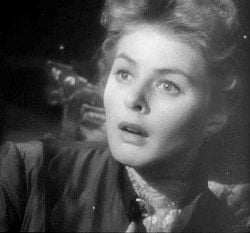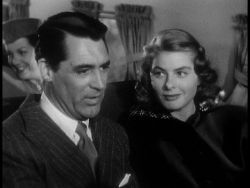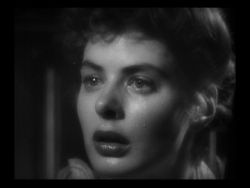Ingrid Bergman
| Ingrid Bergman | |
 Ingrid Bergman in Gaslight, her first Academy Award-winning role. | |
| Birth name: | Ingrid Bergman |
|---|---|
| Date of birth: | August 29 1915 |
| Birth location: | Stockholm, Sweden |
| Date of death: | August 29 1982 |
| Death location: | London, England |
| Academy Awards: | Best Actress 1944 Gaslight 1956 Anastasia Best Supporting Actress 1974 Murder on the Orient Express |
| Spouse: | Dr. Aron Petter Lindström (1937-1950) Roberto Rossellini (1950-1957) Lars Schmidt (1958-1975) |
Ingrid Bergman ▶, (August 29 1915 – August 29 1982) was a three-time Academy Award-winning Swedish actress. In addition, she won two Emmy Awards and one Tony Award. She was ranked as the fourth greatest female star of all time by the American Film Institute.
Early Life
Bergman was born on August 29, 1915, in Stockholm, Sweden. When she was three years old, her mother died. Her father passed away when she was thirteen. She was then sent off to live with an aunt, who died of heart complications only six months later. Ultimately she was raised by another aunt and uncle, who had five children.
At the age of 17, Ingrid Bergman auditioned for and was accepted to the Royal Dramatic Theater in Stockholm. During her first summer break, she was hired at a Swedish film studio, which consequently led to her leaving the Royal Dramatic Theater to work in films full time, after having attended for only one year. Her first film role after leaving the Royal Dramatic Theater was a small part in 1935's Munkbrogreven.
After a dozen films in Sweden, Bergman was signed by Hollywood producer David O. Selznick to star in the 1939 English language remake of her 1936 Swedish language film, Intermezzo. It was an enormous success and Bergman became a star, described as "Sweden's illustrious gift to Hollywood". Some things that set her apart from other female stars in Hollywood at that time were that she did not change her name, her appearance was entirely natural with little to no makeup, and that she was one of the tallest leading ladies.
Hollywood Career

.
After completing one last film in Sweden and appearing in three moderately successful films in the United States, Bergman joined Humphrey Bogart in the 1942 classic film Casablanca, which remains her most recognizable role.
That same year, she received her first Academy Award nomination for Best Actress for For Whom the Bell Tolls (1943), which was also her first color film. The following year she won the Academy Award for Best Actress for Gaslight (1944). She received a third consecutive nomination for Best Actress with her performance as a nun in The Bells of St. Mary's (1945). Later, she would receive another Best Actress nomination for her portrayal of Joan of Arc in the movie by the same name (1948). It was an independent film produced by Walter Wanger and initially released through RKO, which Bergman had championed since her arrival in Hollywood and which she had previously acted in as a stage play. The film was not a big hit, and received disastrous reviews. It was subsequently shortened of 45 minutes, and it was not until its restoration to full length in 1998 and its 2004 appearance on DVD that later audiences could see it as it was intended to be shown.
She also starred in the Alfred Hitchcock films Spellbound (1945), Notorious (1946), and Under Capricorn (1949).
Ingrid Bergman went to Alaska during World War II in order to entertain troops. Soon after the war ended, she also went to Europe for the same purpose, where she was able to see the devastation caused by the war.
Personal Life
On July 10, 1937, at the age of 21, she married a dentist, Petter Lindström. On September 20, 1938, she gave birth to a daughter, Pia Lindström. The marriage ended in divorce.
In 1949, Bergman met Italian director Roberto Rossellini in order to make the film Stromboli (1950), after having been a fan of two of his previous films that she had seen while in the United States. The couple married on May 24 1950 and had one son, Roberto Ingmar Rossellini and twin daughters, Isabella Rossellini, who is a famous actress and model, and Isotta Ingrid Rossellini. Over the next few years, she appeared in several Italian films for Rossellini, including Giovanna d'Arco al rogo (1954), a dramatic oratorio by Arthur Honegger about Joan of Arc. The Rossellini-Bergman marriage ended in divorce on November 7 1957.
Later Life
With her starring role in 1956's Anastasia, Bergman made her post-scandal triumphant return to the American screen and won the Academy Award for Best Actress for a second time. This award was accepted for her by her friend Cary Grant.[1] Bergman would not make her first post-scandal public appearance in Hollywood until the 1958 Academy Awards, when she was the presenter of the Academy Award for Best Picture.[2] Furthermore, after being introduced by Cary Grant and walking out on stage to present, she was given a standing ovation.
Bergman would continue to alternate between performances in American and European films for the rest of her career and also made occasional appearances in television dramas such as a 1959 production of The Turn of the Screw for Startime for which she won an Emmy Award for Outstanding Single Performance by an Actress.
During this time, she also performed in several stage plays. In addition, she married the producer Lars Schmidt, a fellow Swede, on December 21 1958. This marriage ultimately led to divorce in 1975.
In 1972, Senator Charles H. Percy entered an apology into the Congressional Record for the attack made on her 22 years earlier by Edwin C. Johnson.
Bergman received her third Academy Award (and first for Best Supporting Actress) for her performance in Murder on the Orient Express (1974), but she publicly declared at the Academy Awards telecast that year that the award rightfully belonged to Italian actress Valentina Cortese for Day for Night by concluding her acceptance speech with "Please forgive me, Valentina. I didn't mean to."[3]
In 1978, she played in Ingmar Bergman's Höstsonaten (Autumn Sonata) for which she received her seventh Academy Award nomination and made her final performance on the big screen. In the film, Bergman plays a celebrity pianist who returns to Sweden to visit her neglected daughter, played by Liv Ullman. The film was shot in Norway. It is considered by many to be among Ingrid's best performances.
Bergman was honored posthumously with her second Emmy Award for Best Actress in 1982 for the television mini-series A Woman Called Golda, about the late Israeli prime minister Golda Meir. It was her final acting role. One of her co-stars in this mini-series was Leonard Nimoy.
Death
Bergman died in 1982 on her 67th birthday in London, England, following a long battle with breast cancer. Her body was cremated in Sweden. Most of her ashes were scattered in the sea with the remainder being interred in the Norra begravningsplatsen in Stockholm next to her parents. She was honored posthumously by Ingmar Bergman.
Autobiography
In 1980, Bergman's autobiography was published under the title Ingrid Bergman: My Story and was written with the help of Alan Burgess. In the book, Ingrid tells about her childhood, her early career, her life during her time in Hollywood, the Rossellini Scandal, and subsequent events. The book was written after her children warned that she would only be known through rumors and interviews if she did not tell her own story. It was through this autobiography that her affair with Robert Capa became known.
Legacy
For her contributions to the motion picture industry, Ingrid Bergman has a star on the Hollywood Walk of Fame at 6759 Hollywood Blvd. She continues to be a cultural icon - not only for her role in Casablanca, but for her career as a whole and for her innocent, natural beauty. In addition, she is considered by many to be one of the foremost actresses of the 20th century.
ReferencesISBN links support NWE through referral fees
- Bergman, Ingrid and Burgess, Alan (1980). Ingrid Bergman: My Story. New York: Delacorte Press. ISBN 0-440032-99-7.
- Leamer, Laurence (1986). As Time Goes By: The Life of Ingrid Bergman. New York: Harper & Row. ISBN 0-060154-85-3.
External links
- Ingrid Bergman website by her family
- Ingrid Bergman site run by CMG
- Ingrid Bergman Collection at Wesleyan University
- 1943 New York Times Interview
- Larry King transcript with Ingrid Bergman's daughters on the 60th anniversary of Casablanca
- Excerpt from Isabella Rossellini's Some of Me that describes Ingrid Bergman's passion for cleaning
- TCM Confidential: Ingrid Bergman
- The Complete Ingrid Bergman Page - A Fansite
| Awards | ||
|---|---|---|
| Preceded by: Jennifer Jones for The Song of Bernadette |
Academy Award for Best Actress 1944 for Gaslight |
Succeeded by: Joan Crawford for Mildred Pierce |
| Preceded by: Anna Magnani for The Rose Tattoo |
Academy Award for Best Actress 1956 for Anastasia |
Succeeded by: Joanne Woodward for The Three Faces of Eve |
| Preceded by: Tatum O'Neal for Paper Moon |
Academy Award for Best Supporting Actress 1974 for Murder on the Orient Express |
Succeeded by: Lee Grant for Shampoo |
| Preceded by: None |
Tony Award for Best Performance by a Leading Actress in a Play 1947 for Joan of Lorraine (tied with Helen Hayes for Happy Birthday) |
Succeeded by: Judith Anderson for Medea, Katharine Cornell for Antony and Cleopatra, and Jessica Tandy for A Streetcar Named Desire (tie) |
Credits
New World Encyclopedia writers and editors rewrote and completed the Wikipedia article in accordance with New World Encyclopedia standards. This article abides by terms of the Creative Commons CC-by-sa 3.0 License (CC-by-sa), which may be used and disseminated with proper attribution. Credit is due under the terms of this license that can reference both the New World Encyclopedia contributors and the selfless volunteer contributors of the Wikimedia Foundation. To cite this article click here for a list of acceptable citing formats.The history of earlier contributions by wikipedians is accessible to researchers here:
The history of this article since it was imported to New World Encyclopedia:
Note: Some restrictions may apply to use of individual images which are separately licensed.
- ↑ 1957 Academy Awards. Internet Movie Database. Retrieved 2006-10-23.
- ↑ Gary Moody. All the Oscars: 1958. the OscarSite.com - A celebration of all things Oscar. Retrieved 2006-12-10.
- ↑ Gary Moody. All the Oscars: 1974. the OscarSite.com - A celebration of all things Oscar. Retrieved 2006-12-10.
